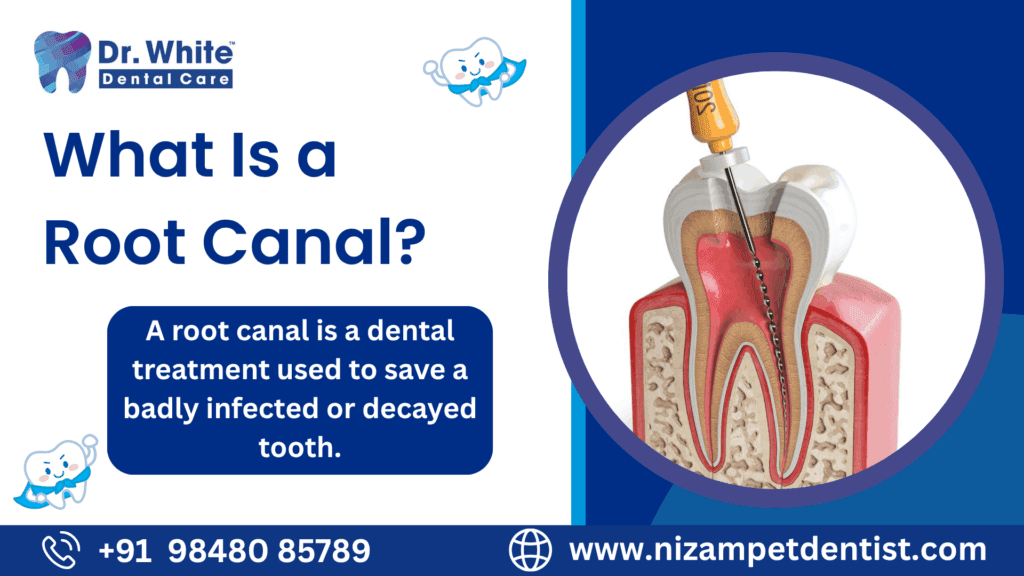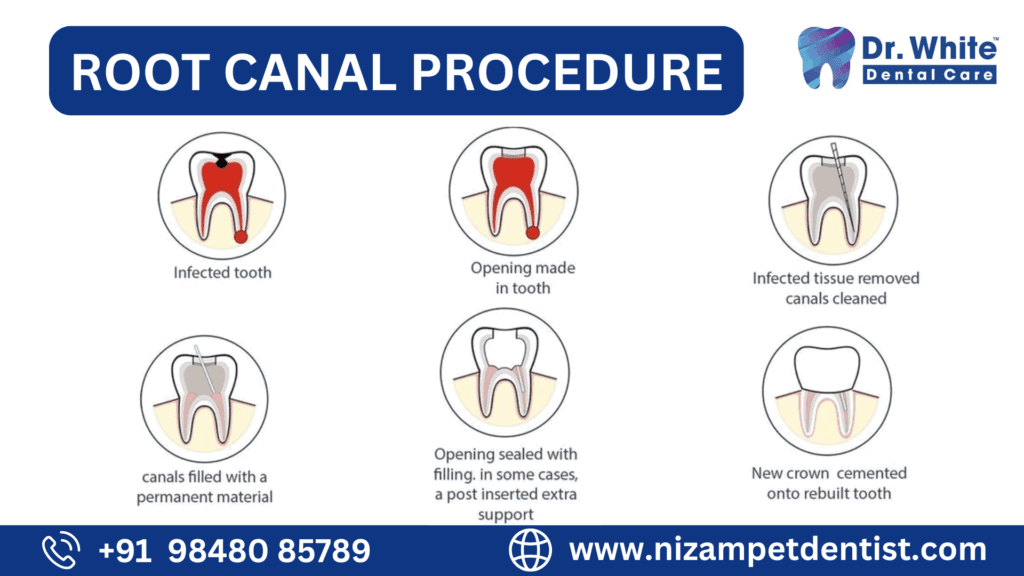Do Root Canal Treatments Hurt

Worried that a root canal might be painful? You’re not alone. Many people still believe root canals are scary and painful—but that’s no longer true. In the past, this treatment had a bad reputation, but modern dental techniques have completely changed the experience.
Today, root canal treatments are safe, gentle, and often painless—very similar to getting a regular dental filling. In fact, most of the pain people feel is actually before the treatment, due to infection or deep decay in the tooth.
At Nizampet Dentist, we focus on making every patient feel calm, cared for, and completely comfortable. Using the latest technology and pain-free methods, we’ve helped hundreds of people overcome their fear and walk away with healthy, happy smiles.
2. Why Root Canals Have a Bad Reputation
Despite being a routine dental procedure today, root canals still carry a lot of fear and misinformation.
Old Root Canal Techniques Were Painful
- In the past, root canals were done with basic tools and limited anesthesia.
- Patients often experienced discomfort during the procedure, giving the treatment a bad name.
- Unfortunately, these outdated stories still influence people’s perceptions today.
Fear Passed Down from Family or Friends
- Many people fear root canals simply because of what others have told them.
- A parent or friend who had a bad experience years ago may unintentionally pass that fear on.
- These stories often lack context—modern methods are much more advanced and comfortable.
Pain Is Often from the Infection, Not the Procedure
- Most people associate root canals with pain, but they forget the real cause: infection or deep decay.
- The root canal itself actually relieves pain by removing the source of infection inside the tooth.
- When done correctly, the procedure is designed to stop pain—not cause it.
3. What Is a Root Canal and Why Is It Needed?
Many people hear the term root canal but don’t fully understand what it means. Here’s a simple breakdown of the procedure and why it’s so important.
What Is a Root Canal?

- A root canal is a dental treatment used to save a badly infected or decayed tooth.
- Instead of removing the tooth, your dentist cleans out the infected tissue from inside the root canals, disinfects the area, and then seals it.
- It’s a tooth-saving solution that stops pain and prevents further damage.
What Happens Inside Your Tooth?
- Inside every tooth is a soft tissue called the pulp, which contains nerves and blood vessels.
- When decay, deep cavities, or trauma reach the pulp, it becomes infected or inflamed.
- This causes intense tooth pain, swelling, or even pus formation (abscess).
- A root canal removes the infected pulp, cleans the inside of the tooth, and fills it with a special material to prevent reinfection.
Why Avoiding Treatment Makes Things Worse
- Ignoring a tooth infection can lead to severe pain, tooth loss, bone damage, or infection spreading to other areas of the body.
- Over time, the pain may temporarily stop—but the infection can still worsen silently.
- Early treatment with a root canal is faster, safer, and more affordable than waiting for complications.
4. Does the Procedure Hurt? A Step-by-Step Breakdown

One of the biggest fears patients have is whether a root canal will hurt. The good news is—with today’s advanced methods, the procedure is nearly painless. Here’s what actually happens during a root canal
Numbing the Area with Local Anesthesia
- Before starting, the dentist applies a local anesthetic to fully numb the area around your tooth.
- This means you won’t feel pain—just mild pressure or movement during the treatment.
- For most patients, this step is quick and completely effective.
What You’ll Feel During the Procedure
- You might feel pressure or vibration, but not sharp pain.
- The area remains numb throughout the procedure.
- If any discomfort is felt, more anesthesia can be given immediately.
Sedation Options for Nervous Patients
- If you’re feeling anxious, some clinics offer mild sedation or anti-anxiety medication.
- This helps you feel calm and relaxed during the appointment.
- At Nizampetdentist, we customize pain management based on your comfort level.
What Real Patients Usually Say
- Most patients report that the procedure was much easier than they expected.
- Many compare it to getting a filling and often say,
- The real relief comes when the pain from the infection is finally gone.
5. What You Might Feel After the Procedure
Here’s a breakdown of what’s normal, how long it lasts, and when to contact your dentist.
Mild Soreness or Sensitivity Is Normal
- After the numbness wears off, you may feel mild soreness, tenderness, or sensitivity in the treated area.
- This is a natural response, especially if the tooth was infected or inflamed before the procedure.
- The discomfort usually feels like a bruised or sore feeling when biting down.
How Long Does the Discomfort Last?
- Most patients experience slight discomfort for 1 to 3 days.
- In some cases, it can last up to a week—but it typically improves each day.
- Over-the-counter pain relievers like ibuprofen or paracetamol usually manage the pain well.
Tips for Quick Relief and Recovery
- Avoid chewing on the treated side for a few days.
- Stick to soft foods and warm liquids during recovery.
- Maintain good oral hygiene but brush gently near the area.
- Use cold compresses if there’s swelling.
When to Call Your Dentist
Contact your dentist if:
- Pain gets worse after 3 days, not better
- You experience severe swelling, fever, or pus discharge
- There’s a crack or break in the tooth or temporary crown
6. How to Manage Root Canal Pain After Treatment
While root canal treatments are mostly painless, mild discomfort after the procedure is normal. Here’s how you can manage it at home and know when to seek help.
Use Over-the-Counter Pain Relief
- Take pain relievers like ibuprofen or paracetamol as prescribed by your dentist.
- These help reduce inflammation and ease soreness.
- Avoid aspirin unless advised, as it can increase bleeding.
Apply a Cold Compress
- If there’s swelling or tenderness, apply a cold compress to your cheek near the treated area.
- Use it for 10–15 minutes at a time with breaks in between.
- It helps reduce swelling and numb any lingering discomfort.
Stick to Soft Foods for a Few Days
- Choose foods that are soft, warm, and easy to chew—like soups, rice, mashed potatoes, or smoothies.
- Avoid hard, crunchy, or sticky foods that may irritate the area or damage temporary fillings.
Maintain Good Oral Hygiene
- Brush and floss regularly, but be gentle around the treated tooth.
- Keeping the area clean helps prevent infection and speeds up healing.
When to Call Your Dentist
- If pain worsens after 2–3 days, or if you notice fever, swelling, pus, or difficulty opening your mouth, contact your dentist immediately.
- You may need antibiotics or further treatment if an infection develops.
7. Comparing Pain: Root Canal vs. Tooth Extraction
When facing severe tooth pain, patients often ask:
“Which is better — a root canal or a tooth extraction?”
Let’s compare the two options in terms of pain, recovery, and long-term dental health.
Which One Hurts More?
- Most patients are surprised to learn that root canal treatments are less painful than extractions.
- During a root canal, local anesthesia completely numbs the area, and modern techniques ensure a gentle, controlled procedure.
- In contrast, extractions can sometimes involve more pressure, swelling, and longer post-op discomfort, especially if it’s a complicated or surgical extraction.
Recovery Time: Root Canal vs. Extraction
- Root Canal: Recovery is usually smooth and fast. Most patients resume normal activities the next day with minimal soreness.
- Extraction: Healing can take several days to a week or more, with dietary restrictions and increased risk of dry socket or bone loss.
Impact on Long-Term Oral Health
- A root canal saves your natural tooth, maintains jaw structure, and supports proper chewing.
- An extraction leaves a gap, which can lead to shifting teeth, bone loss, or the need for implants/bridges—adding to your cost and treatment time.
- Saving your tooth is always the healthier, more cost-effective option in the long run.
8. How Dentists Make Root Canals Comfortable Today
If the thought of a root canal still makes you nervous, you’re not alone. But here’s the good news: modern root canals are nothing like the old days. Today’s dental technology and techniques have made the entire experience fast, comfortable, and highly effective.
Advanced Technology for Precision and Comfort
- At madinagudadentist.in, we use digital X-rays for accurate, low-radiation imaging to clearly view the inside of your tooth.
- Rotary instruments (modern, motorized tools) allow faster and smoother cleaning of the root canals with less discomfort.
- Dental microscopes help us see even the tiniest canals, ensuring no infection is left behind.
Gentle, Patient-Focused Techniques
- We take extra care to ensure gentle handling of tissues and use effective local anesthesia for a completely numb experience.
- Nervous or anxious? We offer comfort-first care, including calm explanations and options to help you relax throughout your visit.
Trained Specialists for Complex Cases
- Some root canal cases are best handled by endodontists—dentists who specialize in root canal procedures.
- Some root canal cases are best handled by endodontists—dentists who specialize in root canal procedures.
- At our clinic, experienced professionals manage every case with care, whether it’s straightforward or more advanced.
9. How to Prevent the Need for a Root Canal
While root canal treatment is an effective way to save an infected tooth, the best treatment is prevention. With simple daily habits and timely dental care, you can avoid serious tooth problems before they start.
Practice Good Oral Hygiene Daily
- Brush your teeth twice a day with fluoride toothpaste.
- Floss once a day to remove plaque between teeth.
- Rinse with an antibacterial mouthwash to reduce harmful bacteria.
- These habits prevent cavities and gum disease—two major causes of root infections.
Don’t Skip Regular Dental Checkups
- Visit your dentist every 6 months for cleanings and oral exams.
- Regular checkups help detect early signs of decay or infection—before they become painful or complicated.
- At madinagudadentist.in, we use advanced tools to catch issues early and treat them gently.
Treat Cavities and Tooth Damage Early
- Small cavities can be easily filled—but if ignored, they can spread to the root and require a root canal.
- Get any tooth sensitivity, cracks, or swelling checked right away.
- Early treatment is faster, less painful, and more affordable than waiting.
We are here
Enquire Now
Error: Contact form not found.
FAQ'S
- Modern root canals are virtually painless due to effective local anesthesia.
- Most patients feel only slight pressure, not sharp pain.
- It’s often less painful than the toothache caused by the infection.
- Mild soreness may last 1 to 3 days, depending on the infection.
- Discomfort is usually managed with over-the-counter painkillers.
- If pain worsens after 3 days, you should contact your dentist.
- It’s natural to feel nervous, but modern techniques make it comfortable.
- Dentists now use gentle tools and calming methods.
- Many patients say, “It wasn’t as bad as I expected.”
- The tooth may become more brittle and need a crown for protection.
- It’s not 100% guaranteed if the infection is too deep or complex.
- Slight risk of re-infection, especially if aftercare is poor.
- Yes, the treated tooth is slightly weaker and more fragile.
- A dental crown is often placed to restore strength.
- With proper care, the tooth can still function like normal.
- Many root canals can last 10–20 years or longer with good care.
- Longevity depends on oral hygiene and proper crown placement.
- Regular dental checkups help ensure it stays healthy long-term.
- A root canal saves your natural tooth, which is always the better option.
- Extractions may lead to bone loss and shifting teeth.
- Root canals are less invasive and better for long-term dental health.
- With anesthesia, the procedure is not painful at all.
- You may feel minor pressure, but not actual pain.
- If discomfort is felt, dentists can administer more numbing instantly.
- Severe toothache when chewing or applying pressure.
- Swelling, tenderness, or dark discoloration of the tooth.
- Lingering sensitivity to hot or cold, even after the source is removed.
- If the tooth is too damaged or infected beyond repair, extraction may be needed.
- Bone loss or tooth fractures below the gumline are usually not restorable.
- Early diagnosis can prevent reaching the “too late” stage.
During treatment, local anesthesia makes the procedure nearly painless.
You may feel slight discomfort for 1–2 days after the treatment.
Pain after root canal is usually less than the pain caused by the infected tooth.
Yes, many root canals can be completed in a single visit, especially with modern tools.
Complex cases or severe infections may need 2–3 sittings.
Your dentist will decide based on your tooth’s condition.
Severe toothache, especially while chewing or at night.
Sensitivity to hot or cold that lingers after the source is removed.
Swelling, pus, or a pimple-like bump on the gum near the tooth.
Mild pain or sensitivity can last for 1–3 days after the procedure.
Pain usually goes away with over-the-counter medication.
If pain lasts more than a week, contact your dentist for a check-up.
Root canal saves your natural tooth, which helps in chewing and maintaining jaw health.
Tooth extraction may lead to bone loss and shifting of nearby teeth if not replaced.
In most cases, root canal is the better long-term solution unless the tooth is severely damaged.
